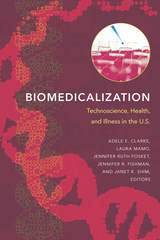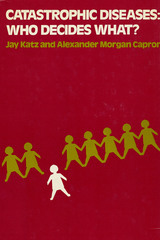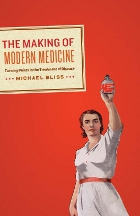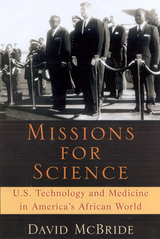
Many people in developing countries lack access to health technologies, even basic ones. Why do these problems in access persist? What can be done to improve access to good health technologies, especially for poor people in poor countries?
This book answers those questions by developing a comprehensive analytical framework for access and examining six case studies to explain why some health technologies achieved more access than others. The technologies include praziquantel (for the treatment of schistosomiasis), hepatitis B vaccine, malaria rapid diagnostic tests, vaccine vial monitors for temperature exposure, the Norplant implant contraceptive, and female condoms.
Based on research studies commissioned by the Bill & Melinda Gates Foundation to better understand the development, adoption, and uptake of health technologies in poor countries, the book concludes with specific lessons on strategies to improve access. These lessons will be of keen interest to students of health and development, public health professionals, and health technology developers—all who seek to improve access to health technologies in poor countries.

Robotic exoskeletons that allow stroke survivors to regain use of their limbs, 3D-printed replacement body parts, and dozens of other innovations still in schematic design are revolutionizing the treatment of debilitating injuries and nervous system disorders. What all these technologies have in common is that they are modeled after engineering strategies found in nature—strategies developed by a vast array of organisms over eons of evolutionary trial and error.
Eugene Goldfield lays out many principles of engineering found in the natural world, with a focus on how evolutionary and developmental adaptations, such as sensory organs and spinal cords, function within complex organisms. He shows how the component parts of highly coordinated structures organize themselves into autonomous functional systems. For example, when people walk, spinal cord neurons generate coordinated signals that continuously reorganize patterns of muscle activations during the gait cycle. This self-organizing capacity is just one of many qualities that allow biological systems to be robust, adaptive, anticipatory, and self-repairing. To exploit the full potential of technologies designed to interact seamlessly with human bodies, properties like these must be better understood and harnessed at every level, from molecules to cells to organ systems.
Bioinspired Devices brings together insights from a wide range of fields. A member of the Wyss Institute for Biologically Inspired Engineering, Goldfield offers an insider’s view of cutting-edge research, and envisions a future in which synthetic and biological devices share energy sources and control, blurring the boundary between nature and medicine.

Contributors. Natalie Boero, Adele E. Clarke, Jennifer R. Fishman, Jennifer Ruth Fosket, Kelly Joyce, Jonathan Kahn, Laura Mamo, Jackie Orr, Elianne Riska, Janet K. Shim, Sara Shostak


The authors of these eight essays examine the social and ethical implications of new biomedical technologies—from behavior control to organ transplants and human experimentation. They also examine the shortcomings in our system of medical care—from the disappearance of the general practitioner to problems of medical care for the poor.
In an introductory essay, Irene Taviss analyzes the allocation of resources to biomedical research and medical care and considers problems related to human experimentation, organ transplantation, and genetic and behavior control. She also discusses possible controls in these fields—legal controls as well as formal professional codes and informal professional practices. In discussing the rare disease phenylketonuria, a cause of mental retardation, Samuel P. Bessman and Judith P. Swazey point out the dangers of a hasty decision to institute legislative controls of diseases on the basis of inadequate scientific evidence. In separate essays, Edmund D. Pellegrino and Louis Lasagna examine the problems of establishing professional controls over different kinds of human experimentation. Everett P. Mendelsohn, Judith P. Swazey, and Irene Taviss present an overview of the new behavior control technologies and point out the dilemmas that have resulted from these developments. Victor Sidel's essay examines the effects of new technologies on the practice of medicine and the potential effects on society. The two final essays deal with the organization and delivery of medical care. Mark G. Field reports on the problems caused by medical specialization and the disappearance of the general practitioner and proposes some remedies. John H. Knowles analyzes medical manpower shortages in various specialties and the effects of these shortages on the health care of the nation.

At the dawn of the twenty-first century, we have become accustomed to medical breakthroughs and conditioned to assume that, regardless of illnesses, doctors almost certainly will be able to help—not just by diagnosing us and alleviating our pain, but by actually treating or even curing diseases, and significantly improving our lives.
For most of human history, however, that was far from the case, as veteran medical historian Michael Bliss explains in The Making of Modern Medicine. Focusing on a few key moments in the transformation of medical care, Bliss reveals the way that new discoveries and new approaches led doctors and patients alike to discard fatalism and their traditional religious acceptance of suffering in favor of a new faith in health care and in the capacity of doctors to treat disease. He takes readers in his account to three turning points—a devastating smallpox outbreak in Montreal in 1885, the founding of the Johns Hopkins Hospital and Medical School, and the discovery of insulin—and recounts the lives of three crucial figures—researcher Frederick Banting, surgeon Harvey Cushing, and physician William Osler—turning medical history into a fascinating story of dedication and discovery.
Compact and compelling, this searching history vividly depicts and explains the emergence of modern medicine—and, in a provocative epilogue, outlines the paradoxes and confusions underlying our contemporary understanding of disease, death, and life itself.

How is medicine doing at the end of the twentieth century? While there has been no end of studies of our health care system and proposals for changing it, there have been few credible studies of the risks and benefits of widely used medical treatments. We simply do not always know whether one treatment is better than another or whether a particular drug is worth the price.
Medical technology assessment is the discipline that studies what does and does not work in medicine. Howard Frazier and Frederick Mosteller are leading figures in this field. In Medicine Worth Paying For they attempt something completely new: to distill the methods and knowledge base of their highly specialized discipline into a text that is accessible—and therefore of great value—to a nontechnical audience.
This book calls attention to the importance of technology assessment in medicine—the rigorous evaluation of the effects of medical treatments—with particular reference to medical innovations. Also, making use of a series of carefully selected cases, the authors identify important policy implications that can be drawn from the study of successful medical innovations. These case studies of medical successes are a rich source of examples of the effects, good and bad, of the application of technology to health care and of attempts to influence the diffusion of technologies in health care.
Medicine Worth Paying For should be of interest to a variety of readers, particularly those concerned with health policy, investigators studying health services, those in the health professions, nonprofessionals who wish to maintain and improve the performance of the health care system, and others who simply want a system that provides benefits greater than risks at an acceptable financial cost.

--What specific technologies and medical resources were transferred by U.S. institutions to black populations centers and why?
--How did the professed aims of U.S. technical projects, public health, and military activities differ from their actual effects and consequences?
--Did the U.S. technical transfer amount to a form of political hegemony?
--What lessons can we learn from the history of technology and medicine in these key geographic regions?
Missions for Science is the first book to explain how modern industrial and scientific advances shaped black Atlantic population centers. McBride is the first to provide a historical analysis of how shifting environmental factors and disease-control aid from the United States affected the collective development of these populations. He also discusses how independent black Atlantic republics with close historical links to the United States independently envisioned and attempted to use science and technology to build their nations.

The comparisons presented here confirm that the use of medical technology in treatment for heart attack is strongly related to incentives, and that technological change is an important cause of medical expenditure growth in all developed countries. Each participating research team reviewed the economic and regulatory incentives provided by their country's health system, and major changes in those incentives over the 1980s and 1990s, according to a commonly used framework. Such incentives include: the magnitude of out-of-pocket costs to patients, the generosity of reimbursement to physicians and hospitals, regulation of the use of new technologies or the supply of physicians, regulation of competition, and the structure of hospital ownership. Each team also reviewed how care for heart attacks has changed in their country over the past decade.
The book will be of enormous importance to health economists, medical researchers and epidemiologists, and policymakers.
Mark McClellan is Associate Professor of Economics and of Medicine and, by courtesy, of Health Research and Policy, Stanford University. He is a National Fellow, the Hoover Institution. Daniel P. Kessler is Associate Professor of Economics, Law, and Policy in the Graduate School of Business, Stanford University, and a Research Fellow, the Hoover Institution.
READERS
Browse our collection.
PUBLISHERS
See BiblioVault's publisher services.
STUDENT SERVICES
Files for college accessibility offices.
UChicago Accessibility Resources
home | accessibility | search | about | contact us
BiblioVault ® 2001 - 2024
The University of Chicago Press









